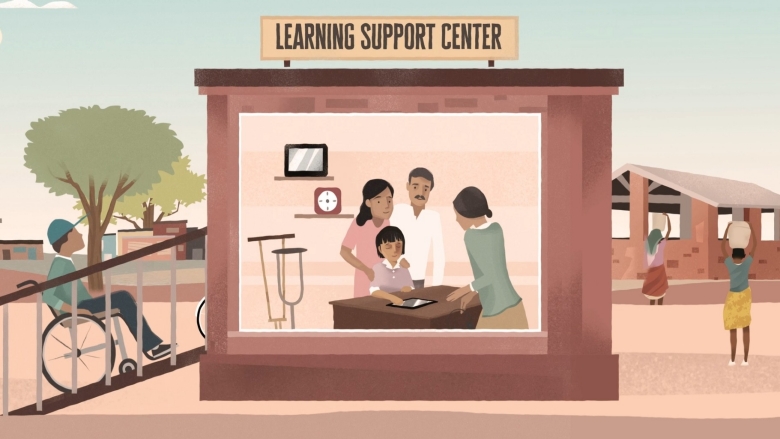For the disability community and all people, the International Day of Persons with Disabilities is a time to celebrate the steady progress made by people with disabilities in asserting their rights around the world, to reflect on the value of the world’s diversity, to learn from the lived experiences of people with disabilities, and to plan future actions to promote inclusive and accessible societies.
In 1992, after a decade of awareness-raising and change efforts to improve the situation of persons with disabilities and provide equal opportunities for them, the international community designated December 3rd as International Day of Disabled Persons.
This year’s theme, “The Future is Accessible,” is an opportunity to create a vision for an inclusive world where buildings, transport and communities are accessible and people with disabilities have equal opportunities to learn, grow and thrive in society with dignity and without fear of discrimination.
More than a year after announcing its 10 disability-inclusive development commitments, the World Bank continues to make progress toward accessibility, particularly Commitment 6: “By 2025, ensure that all World Bank-financed urban transport and rail projects that support public transport services are disability-inclusive.” Some examples:
In Africa, the Dakar Bus Rapid Transit (BRT) project in Senegal is designed with special accessibility features to accommodate the mobility needs of women, children, the elderly, and people with disabilities. Features include bus boarding and alighting infrastructure with ramp access to get to stations, pedestrian infrastructure such as new or renovated sidewalks and walkways along corridors, and adequate lighting at bus stops to ensure safer and easier access to public transport. In the Vietnam Urban Improvement Project, people with disabilities became partners in the design and implementation of infrastructure access improvements. The project team partnered with a Japanese NGO to bring an architect into the team to incorporate universal design into the project. This architect, who is disabled, not only added value to the team with his expertise but also enhanced the accessibility needs of the project. In China, ongoing railway projects (Hajia Railway and Zhanghu Railway) are accommodating the needs of people with disabilities and mobility restrictions within the stations, including boarding trains and accessing platforms with elevators. In Lima, for example, the World Bank piloted an intervention and developed a design manual in meaningful consultation with people with disabilities and civil society organizations. The manual was well received and was adopted by the city’s transportation department, which is using it to design the city’s bus rapid transit system.
The next step to achieving an accessible future is to scale. It is therefore encouraging that disability inclusion is now a cross-cutting theme for the International Development Association, the World Bank’s fund for the poorest countries. To further advance disability inclusion, IDA19 calls for investments in disability-disaggregated data, differentiated interventions across sectors, and promoting inclusion through accessible physical environments and technology.
The International Day of Persons with Disabilities is both a day to celebrate progress, but also a day of reflection to recognise and address the significant gaps in access, participation and opportunity that people with disabilities continue to face.
Here are some hard facts to consider:
Poverty is a reality for people with disabilities. The proportion of people with disabilities living below the national or international poverty line is higher than for people without disabilities, in some countries twice as high. The health and well-being of people with disabilities is at greater risk. People with disabilities are three times less likely to receive medical care when they need it. Children with disabilities are twice as likely to be malnourished and 10 times more likely to become seriously ill. Education and employment opportunities are scarce. People with disabilities are less likely to attend school and complete primary education than people without disabilities, and they are more likely to be illiterate. The employment rate for people with disabilities over the age of 15 is almost half that of people without disabilities. People with disabilities are often the most vulnerable in society, and so they face more difficult barriers to accessing transport, housing and other services. People with disabilities are often excluded, which makes it harder for them to improve their lives and take advantage of economic opportunities.
There are no quick win solutions, but part of the answer lies in promoting equal opportunity.
That’s why without these investments, people are denied the opportunity to realize their potential, and everyone loses.
To protect developing countries’ hard-won human development gains from increasing environmental and social risks, the new Environmental and Social Framework (ESF) commits to prohibit discrimination against people with disabilities in projects. In partnership with the ESF, the Disability Inclusion and Accountability Framework provides a roadmap for disability inclusion in the World Bank’s policies, operations, and analytical work.
It is everyone’s responsibility to work towards an accessible future for all. As a leading development institution, the World Bank is in a position and has an obligation to help create an accessible future. On this International Day of Persons with Disabilities, let us pledge to contribute to making the world a more inclusive and accessible place for all.

